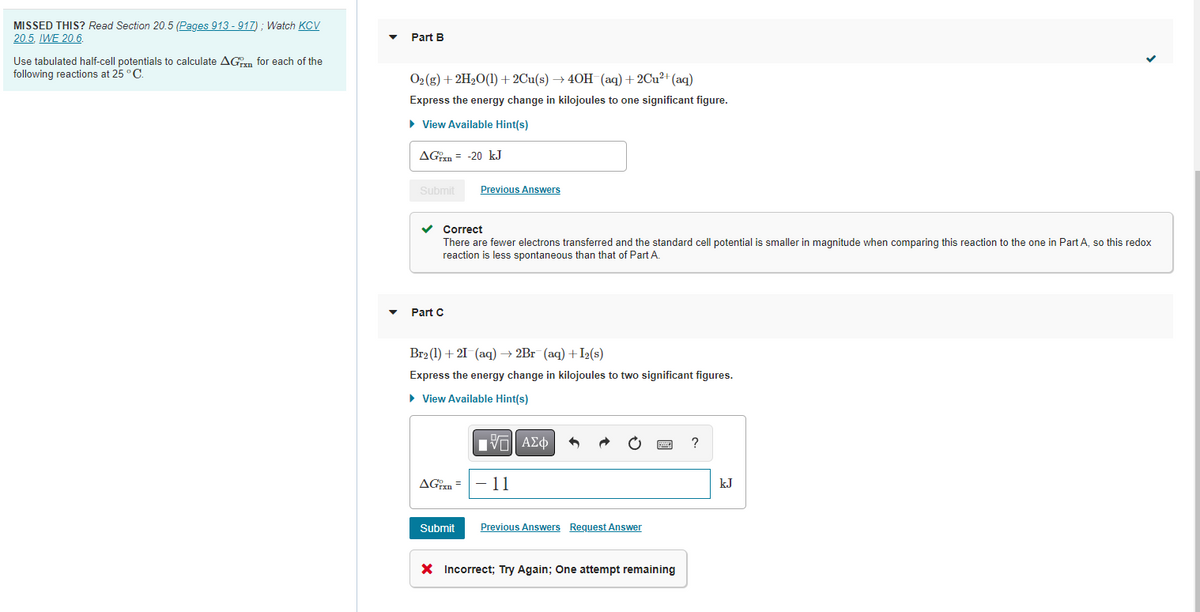ISSED THIS? Read Section 20.5 (Pages 913-917); Watch KCV 0.5, IWE 20.6. se tabulated half-cell potentials to calculate AG for each of the allowing reactions at 25 °C. ▼ Part B O₂(g) + 2H₂O(1) +2Cu(s) →40H (aq) + 2Cu²+ (aq) Express the energy change in kilojoules to one significant figure. ▸ View Available Hint(s) AGE= -20 kJ Submit Previous Answers ✓ Correct There are fewer electrons transferred and the standard cell potential is smaller in magnitude when comparing this reaction to the one in Part A, so this redox reaction is less spontaneous than that of Part A. Part C Br2 (1)+21 (aq) → 2Br (aq) + I₂(s) Express the energy change in kilojoules to two significant figures. ▸ View Available Hint(s) [5] ΑΣΦ AG-11 Submit Previous Answers Request Answer X Incorrect; Try Again; One attempt remaining ? kJ
ISSED THIS? Read Section 20.5 (Pages 913-917); Watch KCV 0.5, IWE 20.6. se tabulated half-cell potentials to calculate AG for each of the allowing reactions at 25 °C. ▼ Part B O₂(g) + 2H₂O(1) +2Cu(s) →40H (aq) + 2Cu²+ (aq) Express the energy change in kilojoules to one significant figure. ▸ View Available Hint(s) AGE= -20 kJ Submit Previous Answers ✓ Correct There are fewer electrons transferred and the standard cell potential is smaller in magnitude when comparing this reaction to the one in Part A, so this redox reaction is less spontaneous than that of Part A. Part C Br2 (1)+21 (aq) → 2Br (aq) + I₂(s) Express the energy change in kilojoules to two significant figures. ▸ View Available Hint(s) [5] ΑΣΦ AG-11 Submit Previous Answers Request Answer X Incorrect; Try Again; One attempt remaining ? kJ
Principles of Modern Chemistry
8th Edition
ISBN:9781305079113
Author:David W. Oxtoby, H. Pat Gillis, Laurie J. Butler
Publisher:David W. Oxtoby, H. Pat Gillis, Laurie J. Butler
Chapter17: Electrochemistry
Section: Chapter Questions
Problem 76AP
Related questions
Question
Please give only part c answer in detail.

Transcribed Image Text:MISSED THIS? Read Section 20.5 (Pages 913-917); Watch KCV
20.5, IWE 20.6.
Use tabulated half-cell potentials to calculate AG for each of the
following reactions at 25 °C.
Part B
O2(g) + 2H₂O(1) + 2Cu(s) →4OH(aq) + 2Cu²+ (aq)
Express the energy change in kilojoules to one significant figure.
► View Available Hint(s)
AG-20 kJ
Submit
Correct
There are fewer electrons transferred and the standard cell potential is smaller in magnitude when comparing this reaction to the one in Part A, so this redox
reaction is less spontaneous than that of Part A.
Part C
Previous Answers
Br₂ (1) +21 (aq) → 2Br¯(aq) + I₂(s)
Express the energy change in kilojoules to two significant figures.
► View Available Hint(s)
AG=
Submit
VE ΑΣΦ
- 11
Previous Answers Request Answer
X Incorrect; Try Again; One attempt remaining
?
kJ
Expert Solution
This question has been solved!
Explore an expertly crafted, step-by-step solution for a thorough understanding of key concepts.
Step by step
Solved in 2 steps with 1 images

Knowledge Booster
Learn more about
Need a deep-dive on the concept behind this application? Look no further. Learn more about this topic, chemistry and related others by exploring similar questions and additional content below.Recommended textbooks for you

Principles of Modern Chemistry
Chemistry
ISBN:
9781305079113
Author:
David W. Oxtoby, H. Pat Gillis, Laurie J. Butler
Publisher:
Cengage Learning

Chemistry: An Atoms First Approach
Chemistry
ISBN:
9781305079243
Author:
Steven S. Zumdahl, Susan A. Zumdahl
Publisher:
Cengage Learning

Chemistry
Chemistry
ISBN:
9781305957404
Author:
Steven S. Zumdahl, Susan A. Zumdahl, Donald J. DeCoste
Publisher:
Cengage Learning

Principles of Modern Chemistry
Chemistry
ISBN:
9781305079113
Author:
David W. Oxtoby, H. Pat Gillis, Laurie J. Butler
Publisher:
Cengage Learning

Chemistry: An Atoms First Approach
Chemistry
ISBN:
9781305079243
Author:
Steven S. Zumdahl, Susan A. Zumdahl
Publisher:
Cengage Learning

Chemistry
Chemistry
ISBN:
9781305957404
Author:
Steven S. Zumdahl, Susan A. Zumdahl, Donald J. DeCoste
Publisher:
Cengage Learning


Chemistry & Chemical Reactivity
Chemistry
ISBN:
9781337399074
Author:
John C. Kotz, Paul M. Treichel, John Townsend, David Treichel
Publisher:
Cengage Learning

Chemistry: The Molecular Science
Chemistry
ISBN:
9781285199047
Author:
John W. Moore, Conrad L. Stanitski
Publisher:
Cengage Learning